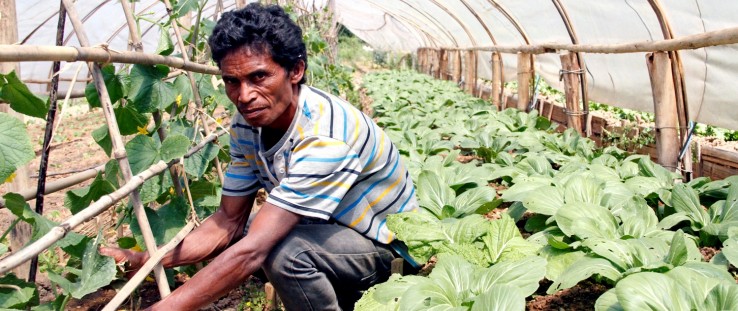 Farmer Alberto Martins is using modern techniques learned from USAID’s horticulture value-chain project to install plastic tunnels to protect crops and reduce losses and to lengthen the growing season with drip irrigation.
Cristóvão Guterres, USAID
Farmer Alberto Martins is using modern techniques learned from USAID’s horticulture value-chain project to install plastic tunnels to protect crops and reduce losses and to lengthen the growing season with drip irrigation.
Cristóvão Guterres, USAID
 Farmer Alberto Martins is using modern techniques learned from USAID’s horticulture value-chain project to install plastic tunnels to protect crops and reduce losses and to lengthen the growing season with drip irrigation.
Cristóvão Guterres, USAID
Farmer Alberto Martins is using modern techniques learned from USAID’s horticulture value-chain project to install plastic tunnels to protect crops and reduce losses and to lengthen the growing season with drip irrigation.
Cristóvão Guterres, USAID
Timor-Leste is a small country of just over a million people tucked between Indonesia and Australia. It boasts sandy beaches, beautiful mountain vistas and picturesque valleys, but these scenes belie its poverty. About a third of Timor-Leste’s people live in extreme poverty, earning less than $1.25 a day, and outside of the capital, Dili, most rely on subsistence agriculture.
USAID has worked with Timor-Leste since the country’s independence in 2002 to address issues—such as widespread reliance on subsistence farming techniques, the lack of non-farm employment and poor access to markets—that contribute to high rates of extreme poverty, food insecurity and chronically poor nutrition across the country.
One project, Developing Agricultural Communities (DAC), focuses on partnerships to break the cycle of extreme poverty. In partnership with ConocoPhillips, DAC introduces modern farming techniques to poor communities to boost their agricultural production, and in partnership with commercial wholesalers and retailers, the project links the farmers to high-demand and high-value markets in Dili.
“These approaches tackle poverty directly,” said Dennis Wesner, economic growth office director for USAID’s mission in Timor-Leste. “They give farmers the means to produce sustainable surplus crops and a guaranteed market; they raise farmer incomes and make them dependable; and they increase access to nutritious vegetables for families across communities.”
USAID’s partnership with ConocoPhillips began in 2009 with two commercial greenhouses in villages near the town of Aileu. This investment offered communities the promise of vegetable production on a commercial scale and year-round harvests for the first time. The communities, however, took some time to accept the new technology and techniques.
Compared to most traditional farming improvements, the massive greenhouses and the complex techniques needed to operate them and keep them productive caused some worry among the participating community members.
“At first it was like someone had just landed a spaceship in the village and wanted to hand over the keys to the farmers,” explained Bruno Benavente, DAC agribusiness adviser.
The unfamiliar requirements of sequential planting, micronutrient application, pest management, cleanliness and detailed recordkeeping could have been obstacles in the farmers’ path to success. Instead, expert trainers from the project and its specialist partners built up the skills of the farmer groups at a pace that matched their needs and their abilities.
Lessons Learned
Not everything went according to plan. For example, in 2012, one greenhouse harvest of tomatoes was lost when visitors brought in a fast-spreading disease on their shoes. But the farmers quickly learned the lesson. They introduced a special sterilizing shoe bath at the entrance for workers and built a viewing platform outside so that visitors could see the facility without endangering its harvests.
Alberto Martins is participating in USAID’s DAC project in Seloi Kraik, a village located in the Aileu district, in the central uplands just south of Dili. Martins grows crops on his land that his contract buyer can sell easily in Dili, like eggplant, lettuce, Chinese cabbage, zucchini, broccoli and spinach.
ConocoPhillips’ investment in the project has brought expert trainers to the village to teach modern agriculture techniques to the farmers, including Martins, such as how to use plastic tunnels to protect crops and reduce losses and how to lengthen the growing season with drip irrigation.
Increases in productivity mean that Martins now has a steady income throughout the year for the first time in his life, allowing him to expand his production area.
“I used to have difficulty buying drip irrigation hoses and plastic sheeting for tunnels,” Martins said. “But after I joined the horticulture project, the bank trusted me to give me credit. This has helped me a lot, and now I can send my kids to school. I’m very happy that USAID is supporting this project in our area.”
Not all farming communities were ready for commercial greenhouses, but many were ready to learn new technologies and techniques to increase their harvests—and their incomes. The DAC project introduced international best practices suitable for intensive horticulture in Timor-Leste.
Farmers learned about growing crops year-round in mini-greenhouses (easy-to-build plastic tunnels big enough to stand up in). They learned about drip irrigation to maintain production through the dry season. And, they learned how to grow crops closer together to get more production from the same amount of land, and how pest management ensures that those crops survive to harvest time. DAC trainers also showed farmers how to make their own organic fertilizers.
Since the project’s start with 64 farmers and two commercial greenhouses, ConocoPhillips investments have broadened the reach to more than 500 farmers. As farmers’ skills and experience have expanded, so have harvests. Annual increases in harvest sizes have reached more than 40 percent and the annual increase in incomes is more than 60 percent.
Gil Rangel da Cruz, the national director of horticulture in the Ministry of Agriculture and Fisheries, is a strong supporter of USAID’s project. “I’m really impressed to see how much expertise the farmers have developed through this training,” he said. “I can tell from their explanations and their ability to discuss each of the new techniques that they really have learned deeply and are applying this knowledge in their own fields.”
The project’s success prompted Timor-Leste’s Ministry of Agriculture and Fisheries to establish a horticulture working group in mid-2013 to focus on expanding the model to other areas of the country. The first meeting attracted representatives from farming communities, local market traders, commercial buyers and retailers, agriculture suppliers, extension agents, the Timor-Leste Chamber of Commerce, other donors and development partners, and civil society organizations supporting agricultural communities.
The group now meets quarterly and is quickly becoming a key forum to find practical ways to expand the use of modern horticulture techniques and improve links to markets to boost farmer incomes and access to nutritious foods.
The two farmer groups that looked in wonder at the new commercial greenhouses five years ago are now experts in production and management and have formed their own government-recognized associations. In May 2013, USAID transferred full ownership of the greenhouses to them. The value of crop sales from the greenhouses was twice as much in 2013 as 2011 and almost three times as much as 2012, showing how the farmers have learned the technical and problem-solving skills needed for continuous greenhouse production.
Fernando Mausesta has worked in one of the commercial greenhouses for three years and is glad to be a part of the association. “The work in the greenhouses is great for me,” he explained. “The income helps my family and I'm able to save enough to deposit in the bank. And by planting in outdoor beds, I can add more than $50 to my weekly income.”
The regular income has helped Mausesta keep the four of his seven children who are school-age in school—two attend the local public school, one is learning English at a private school nearby, and the oldest one is enrolled in one of the universities in Dili.
In many of the communities that specialize in outdoor horticulture production, incomes have risen by as much as 300 percent. Families can now afford motorbikes and parents proudly send their children to high school. Farmers are replacing their clapboard homes with new houses made of cinderblocks that are better able to withstand wind and rain. Farmers are also reinvesting their profits in new tunnels and irrigation, and teaching their neighbors about the new horticulture techniques so they can reap benefits too.







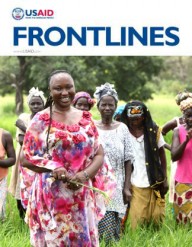

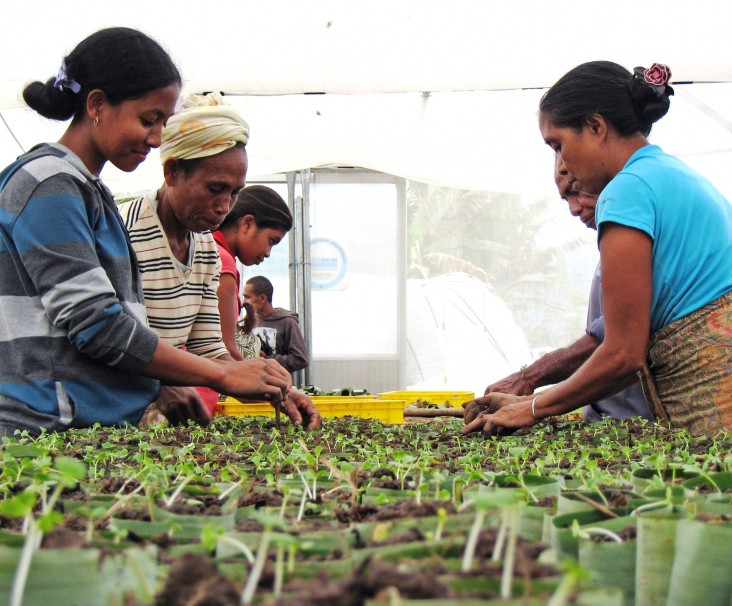
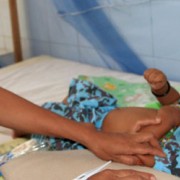

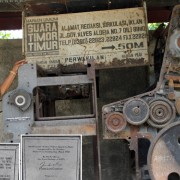
Comment
Make a general inquiry or suggest an improvement.